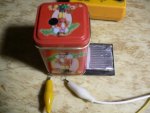Krutz
0
- Joined
- Nov 21, 2007
- Messages
- 1,733
- Points
- 48
hi everyone!
i am about to build more red ld stuff, i have quite a few diodes from Pioneer DVR 109 16x burners. they die at quite random currents, instantly from COD. like between 180 and 400mA, dont remember exactly. therefore my thread about "how to find out the maximum current by watching" some time ago.
will get a thermal powermeter soon (die4thing) hopefully, unfortunately they take quite long for individual measurements. its second problem is that its not here yet, anyway.
so i dug out my solarcell i bought long ago, figured what was wrong with it (foil over the contacts to first rip off), made it into a box, and tried how to get some readings out of it.
here it is, my uncalibrated laserpowermeter, christmas-edition:
i am about to build more red ld stuff, i have quite a few diodes from Pioneer DVR 109 16x burners. they die at quite random currents, instantly from COD. like between 180 and 400mA, dont remember exactly. therefore my thread about "how to find out the maximum current by watching" some time ago.
will get a thermal powermeter soon (die4thing) hopefully, unfortunately they take quite long for individual measurements. its second problem is that its not here yet, anyway.
so i dug out my solarcell i bought long ago, figured what was wrong with it (foil over the contacts to first rip off), made it into a box, and tried how to get some readings out of it.
here it is, my uncalibrated laserpowermeter, christmas-edition:









